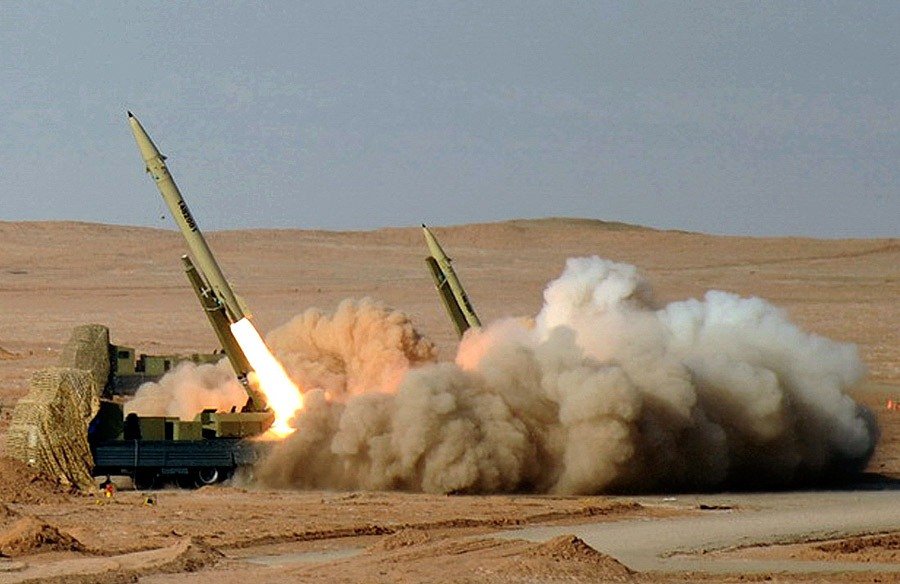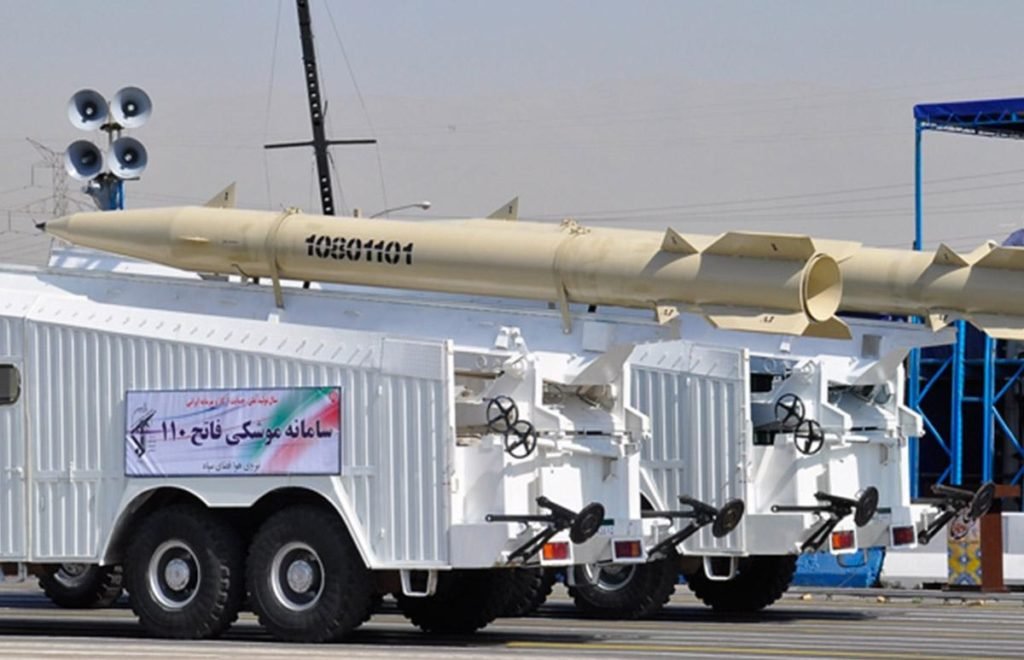Analyzing Iranian Missile Systems: Fateh-110
Recently in the wake of alleged Iranian attacks on atleast 6 Oil Tankers, shooting down of the US drone and the recent news on Iran exceeding the amount of low-enriched uranium it can possess, there is a growing speculation that US and NATO may in future launch attacks on Iran.
We tried to research about different kind of Missiles possessed by Iran. Here are the following categories of Missiles Iran has:-
Safir
Khorramshahr
Qiam-1
Shahab-1
Simorgh
Koksan M1978
Zolfaghar
Emad (Shahab-3 Variant)
Sejjil
Shahab 2 (Scud C-Variant)
Shahab-3
Ghadr 1 (Shahab-3 Variant)
Fateh-110
Tondar 69
Soumar
Ra’ad
We picked up one of the above Missile category Feteh-110 from the above list and tried to get more information on the Missile system. In future we will come up with information with other missile systems as well. In this article we discuss about Fateh-110 missile system.
The Fateh-110 is a short-range, road-mobile, solid-propellant ballistic missile. It is most likely a modified version of the unguided Zelzal-2, with the addition of control and guidance systems. While the program is based in Iran, the missile is believed to incorporate components from Chinese contractors. In 2006, the US Department of Treasury accused Great Wall Industry, a Chinese Corporation, and its partners of playing a lead role in the development of the Fateh missile system. In June 2017, Iran launched six Zolfaghar missiles, a longer-range variant of the Fateh, into Syria in response to attacks by Islamic State militants in Tehran.

Fateh-110 at a Glance
Originated from: Iran
Possessed by: Iran
Class: Short-Range Ballistic Missile (SRBM)
Basing: Road-mobile
Length: 8.86 m
Diameter: 0.61 m
Launch weight: 3,450 kg
Payload: 500 kg
Warhead: HE, chemical, submunitions
Propulsion: Single-stage solid propellant
Range: 200-300 km
Status: Operational
In service: 2004-present
Iran began developing the Fateh-110 in 1995. The missile is 8.86 m long, 0.61 m in diameter, and weighs 3,450 kg. It uses a single-stage solid propellant engine and has a range of 210 km (130 miles), although it is possible that Iran will add extra boosters in order to increase its range to 400 km (249 miles). The missile might be as accurate as 100 m CEP using a combination of inertial guidance and a Global Positioning Satellite (GPS) system, though some sources suggest that the accuracy is much lower. Iranian sources claim that the weapon has a high degree of accuracy, a claim that would suggest in-flight control systems that are not apparent from photos of the missile. It can carry a payload of some 500 kg and is most likely intended to deliver a high explosive, chemical, or submunitions warhead. The missile is also assumed to be nuclear / WMD capable.

The first test flight of the Fateh-110 took place in May 2001, with a second in September of 2002. A third test was recorded in February 2003. A fourth test was successfully completed during the second “Noble Prophet” military exercise in November 2006. The Iranian Revolutionary Guard successfully tested the Fateh in January of 2007 during an annual war game. A fifth successful test was completed in September 2007 alongside the Qadr-1 and the Shahab-3.
Additionally, unconfirmed reports suggest that at least five more tests occurred between 2008 and 2012. 8 During its tests, the Fateh A-110 was fired from a fixed launcher similar to the one used by the Russian S-75 Guideline surface-to-air missile. However, it is likely that Iran has also designed a launch vehicle to make Fateh-110 road mobile. The launch vehicles are probably converted Scud launchers, trucks, or Zelzal-2 launch vehicles.

The missile entered low-rate production in October 2002 and initial operational achievement is believed to have occurred in 2004. Syria is known to have been developing a similar short-range solid-propellant missile and to have exported a similar design to North Korea. Unconfirmed reports from 2008 suggest Hezbollah was supplied with Fateh A-110 rockets by Imad Mughniyeh, a recently deceased officer in the organization who reportedly received these weapons from Iran. It is possible that these were some of the Zelzal weapons destroyed in Lebanon by Israeli forces in 2007. Numbers and production information relating to the Fateh A-110 are currently uncertain, yet Iranian media sources claim that facilities have been created to mass produce the weapon.
Fateh-110 Variants
Iran has also developed two improved versions of the Fateh designated the A-110A (or Fateh 2) and the A-110B (or Fateh 3). A 2008 report suggested that Syria was building a surface-to-surface missile with Iranian assistance. This cooperative project is believed to be based upon the A-110B and have an operational range of at least 300 km.
These are likely the Fateh-110 missiles that the Assad regime launched at opposition groups in the country in December 2012, prompting NATO to deploy Patriot batteries to Turkey. It is expected that the A-110B will have a slightly reduced payload of 480 kg and an accuracy of 250 m CEP. A fourth-generation Fateh-110-D1 was unveiled in August 2012 and was said to have an improved guidance system but the same range as the previous 300 km version.
Zolfaghar
On September 25, 2016, Iranian Defense Minister Hossein Dehghan announced that Iran’s new Zolfaghar ballistic missile, a Fateh-110 variant, has a potential range of 700 km. The newest member of the Fateh-110 family of solid-fueled short-range ballistic missiles, Iran claims that Zolfaghar is equipped with a a submunition warhead . The Iranian Ministry of Defense released a video allegedly showing the Zolfaghar being fired and successfully hitting a small target. The authenticity of the video has not been verified.
Fateh-110 Anti-Ship Variants
In 2014, the IRGC displayed two variants of the Fateh missile it called the Hormuz-1 and Hormuz-2. The Hormuz-1 is claimed to have anti-radiation capabilities for attacking radar systems, and in 2014, Iranian television broadcast images of commanders watching an attack on a target with radar antennae. The original claim was that Hormuz-2 was an anti-ship variant, but images of the missile suggested it had a similar radio frequency-transparent radome and not a window for an electro-optical infrared seeker, suggesting it is essentially the same as the Hormuz-1.
Another anti-ship variant of the Fateh is the Khalij Fars, which does have the electro-optical seeker required to improve accuracy enough to potentially hit a moving target. Tehran claims that early version Khalij Fars entered service in 2008, but was not officially delivered to the Iranian military until a ceremony in March 2014. This ceremony featured Fateh missiles painted blue to suggest an antiship variant, but Iran put caps on the noses of the missile preventing verification of the EO/IR seekers. The Department of Defense did assess in the unclassified version of its 2014 report on the military power of Iran that it does possess an antiship ballistic missile capability.
Follow us at:-
Twitter Handle: @communique_news
Parler Handle: @newscommuniquecom







